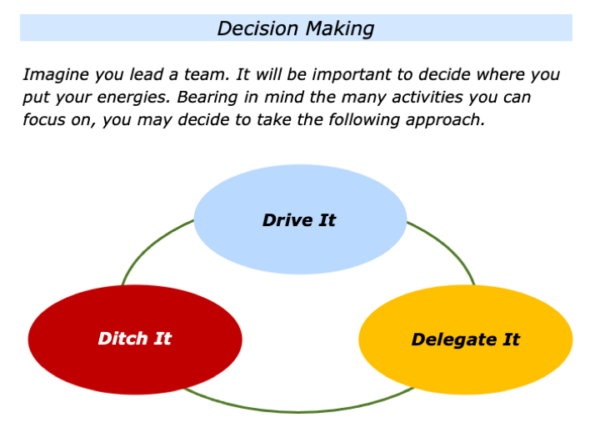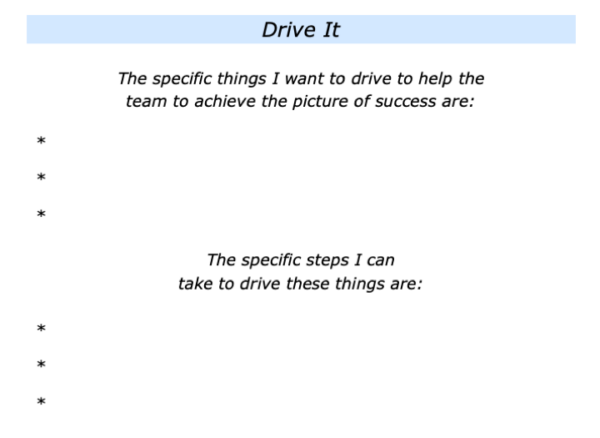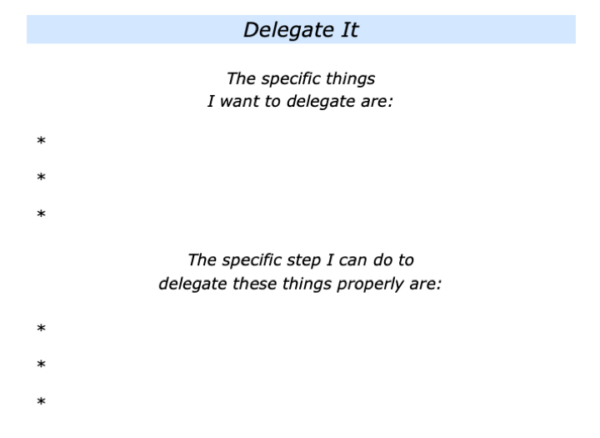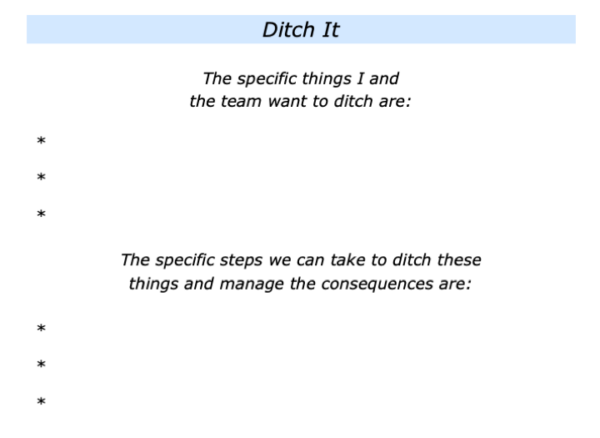
Good leaders aim to drive the key strategies for helping the team to achieve success. They manage their energy properly and aim to be selective to be effective.
Sounds simple in theory, but sometimes the leader’s diary gets crowded as they take on more things to do. One leader described this in the following way.
“My ‘To Do’ list is full and there are only so many jobs I can tackle. My days should be spent driving strategy, but they get consumed by catching-up on tasks.
“I only have so much energy, so it is important to channel this into the activities that will make a real difference. Sometimes at the end of a day it is hard to know what I have achieved.”
Imagine that you lead your team. How can you be effective? Start by listing the things that must be done to deliver the picture of success.
Divide these into three headings: Drive It, Delegate It, Ditch It. Then work through the following steps.
Drive It
Looking at the ‘To Do’ list, start by describing the things that you personally want to drive. The leader mentioned above explained their approach to doing this in the following way.
“I am clear on our team’s goals. I am also clear on the three key strategies we can follow to achieve that goal. I plan to take responsibility for the top two strategies.
“The first strategy is to continually manage and reassure our key stakeholders – my bosses and the banks – by delivering the required profitability.
“The second strategy is to build and maintain a culture in which people can deliver peak performance.
“I will take a hands-on approach to making these two strategies happen. This will also involve working with the right people to ensure we deliver the required results.”
If you wish, try tackling the exercise on this theme. Bearing in mind your ‘To Do’ list, this invites you to do the following. Describe the specific things you want to take responsibility for driving and how you can make these happen.

Delegate It
Looking at your ‘To Do’ list, move on to the things you want to delegate. Delegation sounds easy in theory, but it is vital to do the following things.
To describe the specific outcomes that are required – the picture of success;
To delegate to people who are capable of delivering these outcomes – otherwise you will be spending your time micromanaging them;
To check they have understood the required outcomes – by asking them to play back their understanding – and make sure they want to do the job;
To give them the support required and how they will proactively keep you informed of their progress towards achieving the goals.
The leader mentioned above explained their approach in the following way.
“Looking at our key strategies, I decide to delegate our approach to developing a successful digital arm.
“Certainly I was still accountable for the results, but my Chief Technology Officer was more than capable of making it happen.
“We made clear contracts about the desired outcome, the support required and how they would proactively keep me informed about the progress toward achieving the goal.
“This meant I could sleep more easily at night.”
If you wish, try tackling the exercise on this theme. Bearing in mind your ‘To Do’ list, this invites you to do the following. Describe the specific things you want to delegate and how you can delegate these properly.

Ditch It
Looking at your ‘To Do’ list, describe the things you want to ditch. It will also be important to describe how to manage the consequences of ditching these.
The leader mentioned earlier described their approach in the following way.
“I find it easy to ditch things in theory, but it is more difficult in practise.
“I start out with good intentions, but then get guilty about neglecting certain activities. So I often end up doing these things anyway.
“Bearing this in mind, I gathered my leadership team and we focused on the following things.
“The key strategies we could follow and how we could deliver these successfully.
“The specific things we wanted to ditch – the tasks, projects and other activities – because these were time consuming and did not contribute greatly to achieving the goals.
“The specific things we could do to manage the consequences of ditching these things.
“The discussion became heated at times because it sometimes involved pet projects, but we got there in the end.
“Ditching some activities also had implications for some of our stakeholders.
“Bearing this in mind, I spent quite a lot of time meeting these people and, where appropriate, provided alternative solutions.
“The ditching process eventually went well. It freed up more time for implementing the key strategies and achieving success.”
If you wish, try tackling the exercise on this theme. Bearing in mind the ‘To Do’ list, this invites you to complete the following sentences.







Leave a Reply